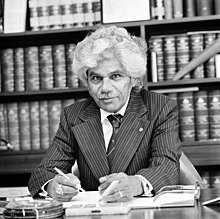Neville Bonner
Neville Bonner | |
|---|---|
 Bonner in 1979 | |
| Senator | |
| In office 11 June 1971 – 4 February 1983 | |
| Preceded by | Dame Annabelle Rankin |
| Personal details | |
| Born | 28 March 1922 Ukerebagh Island, New South Wales, Australia |
| Died | 5 February 1999 (aged 76) Ipswich, Queensland, Australia |
| Nationality | Australian |
| Political party | Liberal (1971–83) Independent (1983) |
| Spouse(s) | Mona Bonner (deceased), Heather Bonner |
| Children | Five Boys |
| Occupation | Politician |
Neville Thomas Bonner AO (28 March 1922 – 5 February 1999) was an Australian politician, and the first Indigenous Australian member of the Parliament of Australia. He was appointed by the Queensland Parliament to fill a vacancy in the Senate. He later became the first Indigenous Australian to be elected to the parliament. Bonner was an elder of the Jagera people.
Biography
[change | change source]Bonner was born on Ukerebagh Island, in the Tweed River in northern New South Wales. He never knew his father and had very little education. He worked on a farm, and in 1946 moved to Palm Island, near Townsville, Queensland. He became Assistant Settlement Overseer.[1]
In 1960, he moved to Ipswich, and joined the board of directors of the One People of Australia League (OPAL).[2] This was an indigenous rights organisation. He became its Queensland president in 1970. He joined the Liberal Party in 1967 and held local office in the party. Following the resignation of Liberal Senator Dame Annabelle Rankin in 1971, Bonner was chosen to replace her. He became the first indigenous Australian to sit in the Australian Parliament. He was elected in his own right in 1972, 1974, 1975 and 1980.
While in the Senate he served on a number of committees. He was never a serious candidate for promotion to the ministry. He rebelled against the Liberal Party policy on some issues. Partly as a result of this, and partly due to pressure from younger candidates, he was dropped from the Liberal Senate ticket at the 1983 election. He stood as an independent and was nearly successful. The Hawke government made him a director of the Australian Broadcasting Corporation.
Bonner was almost unique in being both an indigenous activist and a political conservative. He owed his political career to this combination. Other indigenous activists treated him badly, and they accused him of being a "token" in the Liberal Party.
In 1979, Bonner was jointly named Australian of the Year[3] along with naturalist Harry Butler. In 1984, Bonner was made an Officer of the Order of Australia.[4] From 1992 to 1996, he was member of the Griffith University Council. The university gave him an honorary doctorate in 1993. In 1998, he was elected to the Constitutional Convention as a candidate of Australians for a Constitutional Monarchy.
He died in Ipswich in 1999, at the age 76.
Posthumous honours
[change | change source]The Neville Bonner Memorial Scholarship was set up by the Australian government in 2000. It gives money so that Indigenous Australians can study politics or related subjects at Australian universities.[5]
The Queensland federal electorate of Bonner is named in his honour. A rugby league oval in Ipswich was named the Neville Bonner Sporting Complex in his honour. This oval was the home of an indigenous team, but is now the official home of the Queensland Cup team, the Ipswich Jets. The suburb of Bonner in Canberra, Australia's national capital, also bears his name. The head office of the Queensland Department of Communities, Child Safety and Disability Services is named the "Neville Bonner Building".[6]
Bonner was an active boomerang thrower. One of his boomerangs can be seen at the Old Parliament House in Canberra.[7]
References
[change | change source]- ↑ "Film Australia biography". Archived from the original on 2007-11-08. Retrieved 2008-02-12.
- ↑ "One People of Australia League". Archived from the original on 2013-11-13. Retrieved 2008-07-28.
- ↑ Lewis, Wendy (2010). Australians of the Year. Pier 9 Press. ISBN 978-1-74196-809-5.
- ↑ "It's an Honour". Archived from the original on 2011-06-29. Retrieved 2010-09-07.
- ↑ ANU: Office of the Vice-Chancellor
- ↑ "Projects | Architecture, urban design, planning and interiors | Architectus".
- ↑ "Boomerang Association of Australia". Archived from the original on 2017-02-02. Retrieved 2012-10-11.
Other websited
[change | change source]- Listing of Neville Bonner's life in published media & books Archived 2009-06-14 at the Wayback Machine
- Classroom Resource Archived 2008-07-21 at the Wayback Machine
- Episode on Bonner's life and career on Australian Broadcasting Corporation Radio National's Hindsight program
